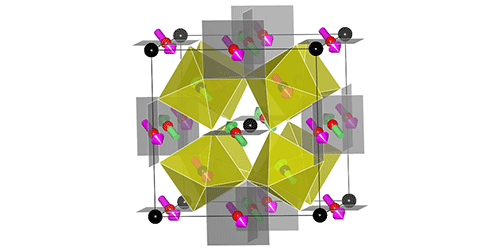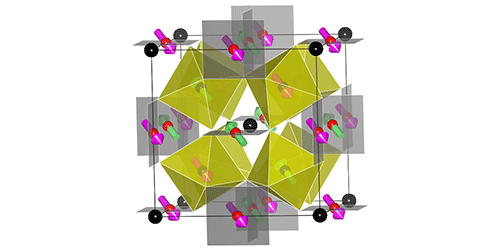Multiferroic Surprise
Multiferroics are materials that inherently exhibit both magnetic and electric polarizations, making them highly prized for spintronic and other magnetoelectric applications. Multiferroicity typically derives from asymmetry in a material’s crystal structure. A new report, however, finds multiferroic behavior in a so-called cubic perovskite, which is highly symmetric. The team explains their unexpected results as arising from a novel interaction between different magnetic ions.
In a multiferroic material, the magnetic polarization is usually produced by transition metal ions (like iron and nickel), while the electric polarization (or ferroelectric effect) often relies on ions that shift position through interactions with their neighbors. These shifts can produce an electric polarization, but only if the crystal structure lacks an inversion center around which the crystal is symmetric.
Cubic crystals have an inversion center, so they are not expected to be multiferroic. But if the magnetization within the cubic material is asymmetric, then it may be possible to magnetically induce a ferroelectric effect. Youwen Long of the Beijing National Laboratory for Condensed Matter Physics in China and his colleagues investigated a cubic perovskite ( LaMn3Cr4O12). The material’s two transition metal ions, manganese and chromium, exhibit magnetic spin ordering along the same direction in the lattice, and this spin pattern lacks an inversion center. When the researchers lowered the temperature to 50 K (at which point the material becomes fully magnetized), they detected electric polarization, suggesting a connection between the material’s magnetism and ferroelectricity. The researchers ruled out previous multiferroic models and instead performed calculations that showed the spin-orbit coupling between the different magnetic ions could produce the electric polarization.
This research is published in Physical Review Letters.
–Michael Schirber





